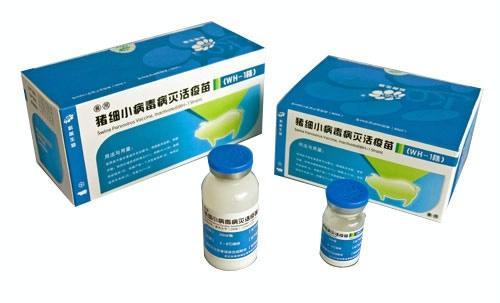鸭细小病毒病灭活疫苗的研究,如何诊断鸭细小病毒病?
鸭细小病毒病灭活疫苗的研究
如何诊断鸭细小病毒病?[病原体]该病为鸭细小病毒引起的急性败血症性传染病,主要影响5-20日龄雏鸭。发病率主要集中在2-4周龄的雏鸭。发病高峰是3周大,所以被称为“三周脖子”。一旦疾病发生,它会在几天内影响整个群体。[诊断] ①该病的主要症状是气喘、腹泻、脱水、脚软、体重迅速减轻

怎样诊断和防治番鸭细小病毒病?
番鸭细小病毒病是由鸭细小病毒引起的急性传染病,影响1-4周龄的番鸭。腹泻和气喘是该疾病的主要症状,其发病率和死亡率相对较高。近年来,番鸭在福建、广东等省养鸭区广泛流行,危害极大。 (1)该病的临床症状多为急性,以本质为首发表现。鸭弓形虫病可用于治疗番鸭细小病毒病。 番鸭细小病毒病是番鸭细小病毒引起的一种番鸭病毒性传染病,仅发生在雏番鸭中。它经常与小鹅瘟混淆,因为它的发病特点与小鹅瘟非常相似。 雏番鸭患此病后死亡率较高,对番鸭养殖业危害极大。 番鸭细小病毒病在自然条件下,除番鸭外,其他幼鸟和成年鸟没有玻璃体疾病。番鸭细小病毒病是由细小病毒引起的,以喘气和腹泻为主要症状。它具有很强的传染性,专门攻击雏番鸭,对0-3周龄的雏番鸭危害最大。因此,它也被称为雏番鸭的“三周颈”。 (1)病原体该疾病的病原体是细小病毒科细小病毒属的成员。病毒颗粒是球形的,没有包膜,是直的。各种抗生素和磺胺类药物对番鸭细小病毒病无治疗和预防作用。高免疫血清和高免疫卵黄抗体可用于治疗。 在番鸭细小病毒病流行的地区或受番鸭细小病毒污染的孵化场,在雏番鸭离开炕后立即皮下注射高免疫血清或卵黄抗体,可以预防和控制疾病的流行和发生。 高,
如何诊断鸭细小病毒病?
如何诊断鸭细小病毒病?[病原体]该病为鸭细小病毒引起的急性败血症性传染病,主要影响5-20日龄雏鸭。发病率主要集中在2-4周龄的雏鸭。发病高峰是3周大,所以被称为“三周脖子”。一旦疾病发生,它会在几天内影响整个群体。[诊断] ①该病的主要症状是气喘、腹泻、脱水、脚软、体重迅速减轻

怎样诊断和防治番鸭细小病毒病?
鸭细小病毒病灭活疫苗的研究范文
点击查看其他>>兽医硕士论文(优秀范文6篇)
兽医硕士论文范文第五篇:鸭细小病毒病灭活疫苗的研究
本文的目录导航:
[标题]鸭细小病毒灭活疫苗的研制
[1.1-1.7]鸭细小病毒灭活疫苗研制简介
[1.8-1.11]细小病毒病原体诊断方法和病毒疫苗研制材料及方法
[第二章]新型鸭细小病毒疫苗的研究成果
[第四章-参考文献]鸭细小病毒灭活疫苗研制的讨论与结论
摘 要
2014年11月以来,我国部分地区所饲养的肉鸭发生了以雏鸭发育迟缓、上下喙萎缩、舌头外伸为特征的疾病。根据其发病临床特征命名为鸭短喙-侏儒综合征(duckshort beak and dwarfism syndrome,SBDS)。本实验室通过病原分离以及动物回归实验,确定了引起SBDS的病原为鸭细小病毒(Duck Parvovirus)。目前,防控该病尚无商业化的疫苗,给我国养鸭业造成了较大经济损失。鉴于此,作者选取鸭细小病毒流行株制备了鸭细小病毒病灭活疫苗,围绕新制品的研制对其实验室试验进行了一些有益的探索。
将15只1日龄的樱桃谷雏鸭随机分成三组:第1组(口服组),每只口服1 m L病毒尿囊液:第2组(肌肉注射组),每只肌肉注射病毒尿囊液1 m L(EID50为10-4.5/0.2m L),第3组(对照组),每只雏鸭口服1 m L生理盐水。在感染鸭细小病毒后7、14、21 d分别对三组动物称重、测量喙长,口服组雏鸭体重极显着低于对照组,肌注组低于对照组,因此确定最佳感染途径为口服途径。
为探明该病毒的生物学特性,将SD株鸭细小病毒用鸭胚传至40代,分别用10、20、30、40代病毒对动物进行攻毒实验。结果表明,F10代鸭细小病毒组雏鸭体重和喙长和对照组差异极显着,感染F20?
F30代病毒组雏鸭体重和喙长与对照组对比差异显着,感染病毒F40代病毒组雏鸭和对照组差异不显着,感染后,21 d均可以检测到排毒。综上所述,该病毒传至40代,病毒对动物的致病力降低。将保存的鸭细小病毒分离株经鸭胚传代五次,收获病毒尿囊液。
9000 r/min离心10 min.取上清,加双抗。将提前处理好的尿囊液和吐温-80按比例制作水相,按照油相和水相2:1比例将二者混匀,制备油乳剂灭活疫苗。并对种毒纯净性和疫苗的外观、粘度、稳定型、安全性和保存期的质量检验。为评价制备的灭活疫苗的免疫效力,将50只1日龄的雏鸭随机分为5组,每组10只,1?
4组为免疫组,免疫剂量分别为100μL、250μL、500μL、1000μL,第 5组为对照组。免疫后7 d进行免疫保护实验,观察实验鸭的临床症状和排毒情况。结果表明疫苗外观为乳白色、油包水型、无外源病毒污染、粘度符合标准、稳定性良好、对动物无不良影响、4℃可保存1年以上;对疫苗安全性检验用20只1日龄雏鸭,随机分为两组,每组10只。一组注射成品疫苗为疫苗组,二组注射白油佐剂为对照组。疫苗组和对照组对比后精神状态正常、注射部位没有发生炎症,证明安全性检验合格;免疫保护实验中,对照组在攻毒后3d泄殖腔肛拭子检测到部分阳性,100μl?1000μL 四组免疫组检测结果全部阴性。攻毒后5 d对照组全部阳性,而1?4组免疫组检测结果全部阴性。直到攻毒21 d后,对照组检测仍然全部呈阳性,四组免疫组检测全部阴性。上述结果表明制备的鸭细小病毒灭活疫苗安全、稳定、易于储存运输,雏鸭免疫后可以获得坚强保护。
本研究通过不同代次病毒接种动物,探明该病毒的生物学特性。为了有效预防本病的蔓延,用该毒株制备鸭细小病毒灭活疫苗,疫苗安全有效,能在雏鸭易感日龄提供保护,为鸭细小病毒疫苗的研制提供了依据。
关键词:鸭细小病毒;鸭短喙-侏儒综合征;灭活疫苗;最小免疫剂量 Abstract
Abstract
Since November 2014, ducks reared in parts of China have developed diseasescharacterized by stunted growth of ducklings, atrophy of the upper and lower jaw, andtongue extension. According to its clinical characteristics, it was named duck short beakand dwarf syndrome (SBDS)。 The laboratory determined that the pathogen responsible forSBDS is duck parvovirus disease through pathogen isolation and animal regressionexperiments. At present, there is no commercial vaccine for the prevention and control ofthe disease, which has caused great economic losses to the domestic duck industry. In viewof this, the duck duck parvovirus epidemic strain was used to prepare an inactivatedvaccine against duck parvovirus disease, and some useful explorations of the laboratoryexperiments were carried out around the development of new products.
Fifteen 1 d Cherry Valley ducklings were randomly divided into three groups: Group1 (oral group), each oral 1 m L of viral allantoic fluid: Group 2 (intramuscular injectiongroup)each only intramuscular injection of 1 m L of virus allantoic fluid (EID50 10-4.5/0.2m L) and group 3 (control group) each duck was orally administered with 1 m L ofphysiological saline. Groups 1 to 2 were housed in the same animal house and the controlgroup was housed in another animal house. After the duck parvovirus was infected, threegroups of animals were weighed and measured for beak length on the 7th, 14th, and 21stdays. The data showed that the weight of the ducklings in the oral group was significantlylower than that of the control group. The intramuscular injection group was lower than thecontrol group, but not significantly, it can be determined that the optimal route of infectionis the oral route.
In order to determine the biological characteristics of the virus, the SD duckparvovirus spread from the duck embryo to 40 generations. Animals were challenged with10, 20, 30, and 40 generations of virus, respectively. Data analysis showed that the bodyweight of infected F10 virus group and control group and duck body length were extremelysignificant. The ducklings infected with the F20?
F30 virus group and the control grouphad significant differences in body weight and body length. There was no significantdifference between the ducklings infected with the F40 virus group and the control group.
Detoxification can be detected within 21 days after infection. In conclusion, the virus reached the 40th generation and the pathogenicity of the virus to animals was reduced.
Specific attenuated vaccines need further study.
The preserved duck parvovirus isolate was passaged through the duck embryo fivetimes and the virus allantoic fluid was harvested. Centrifuge at 9000 r/min for 10 min. Takethe supernatant and add double antibodies. The all processed allantoic fluid and Tween-80were prepared in proportion to the aqueous phase. The oil and aqueous phase were mixedin a ratio of 2:1 to prepare an oil emulsion inactivated vaccine. We also inspected the purityof the virus and the appearance, viscosity, stability, safety and shelf life of the vaccine. Inorder to evaluate the immune efficacy of the prepared inactivated vaccine, 50 1-day-oldducklings were randomly divided into 5 groups, 10 in each group, and 1 to 4 groups wereimmunized groups. The immunization doses were 100 μL, 250 μL, 500 μL, and 1000 μL,respectively.5 groups for the control group. Immunoprotection experiments wereconducted 7 days after immunization to observe the clinical symptoms and detoxificationof the experimental ducks. The results showed that the vaccine had a milky whiteappearance, a water-in-oil type, no foreign virus contamination, a viscosity that was in linewith the standard, good stability, no adverse effects on animals, and could be stored at 4°Cfor more than 1 years; 20 tests for vaccine safety were conducted on the 1st Age-oldducklings were randomly divided into two groups, with 10 in each group. One group ofinjection finished vaccines was the vaccine group, and the other group was injected withwhite oil adjuvant as the control group. After the vaccine group was compared with thecontrol group, the mental state was normal and no inflammation occurred at the injectionsite, which proved that the safety test passed; in the immunoprotection experiment, thecloacae anal swab detected some positive in the challenge group 3 d after the challenge,and 100 μLto 1000 μL of four groups. All the immunization results were negative. Thechallenge group was all positive after 5 days of challenge, while all of the 1?
4 groupswere negative. Twenty-one days after the challenge, the challenge group still testedpositive. All the four groups tested negative. The above results show that the prepared duckparvovirus inactivated vaccine is safe, stable, and easy to store and transport, and ducklingscan obtain strong protection after immunization.
In this study, animals were vaccinated with different generations of viruses tdeterminethe biological characteristics of the virus.In order to effectively prevent the spread of thisdisease, duck inactivated vaccine of duck parvovirus was prepared with the strain, thevaccine was safe and effective,It can provide protection for young ducklings at the age ofsusceptibility, providing a basis for the development of duck parvovirus vaccine.
Keywords:Duck parvovirus;duck short beak and dwarfism syndrom; Inactivatedvaccine; Minimal immunization dose

目录摘要
自2014年11月以来,在中国部分地区饲养的鸭子出现了以雏鸭生长发育迟缓、上下颌骨萎缩和骨骼伸展为特征的疾病。根据其临床特点,被命名为鸭短喙和矮小综合征(SBDS)。实验室通过病原分离和动物回归实验,确定引起鸭细小病毒病的病原为鸭细小病毒病。目前,还没有商业疫苗来预防和控制这种疾病,这给国内养鸭业造成了巨大的经济损失。鉴于此,利用鸭细小病毒流行株制备了鸭细小病毒病灭活疫苗,并围绕新产品开发进行了实验室实验的有益探索。
十五只1 d樱桃谷雏鸭随机分为三组:第1组(口服组),每只鸭口服1毫升病毒尿囊液;第2组(肌肉注射组),每只鸭仅肌肉注射1毫升病毒尿囊液(E ID50 10-4.5/0.2毫升),第3组(对照组),每只鸭口服1毫升生理盐水。第1至第2组被安置在同一动物房内,而对照组被安置在另一动物房内。感染鸭细小病毒后,在第7、14和21天称重并测量三组动物的喙长。数据显示,口服组雏鸭的体重明显低于对照组。肌内注射组低于对照组,但不显著,可以确定感染的最佳途径为口服途径。
为了确定病毒的生物学特性,SD鸭细小病毒从鸭胚传播到40代。动物分别受到10、20、30和40代病毒的攻击。数据分析表明,感染F10病毒组和对照组的体重和鸭体长度极显著。雏鸭感染了F20?
F30病毒组与对照组在体重和体长上有显著差异。感染F40病毒的雏鸭与对照组之间无显著性差异。
可以在感染后21天内检测到解毒。总之,该病毒已进入第40代,对动物的致病性降低。
特定减毒疫苗需要进一步研究。
将保存的鸭细小病毒分离物通过鸭胚胎传代5次,并收获病毒尿囊液。以9000转/分钟的速度离心10分钟。取上清液,加入双抗体。所有处理过的尿囊液和吐温-80与水相成比例制备。油相和水相以2∶1的比例混合,制备油乳剂灭活疫苗。我们还检查了病毒的纯度以及疫苗的外观、粘度、稳定性、安全性和保存期。为评价制备的灭活疫苗的免疫效果,将50只1日龄雏鸭随机分为5组,每组10只,免疫组1 ~ 4只。免疫剂量分别为100 μL、250 μL、500 μL和1000 μL。免疫后7天进行免疫保护试验,观察试验鸭的临床症状和解毒情况。结果表明,该疫苗呈乳白色,油包水型,无外来病毒污染,粘度符合标准,稳定性好,对动物无不良影响,可在4 Cfor条件下保存1年以上;对1日龄雏鸭进行了20次疫苗安全性试验,随机分为两组,每组10次。一组注射成品疫苗为疫苗组,另一组注射白油佐剂为对照组。疫苗组与对照组比较,精神状态正常,注射部位无炎症反应,证明安全试验合格;免疫保护实验中,攻毒后3 d,攻毒组肛拭子检测到部分阳性,四组检测到100 μLto 1000 μL。所有免疫结果均为阴性。挑战组在5天的挑战后都是阳性的,而所有1?
4组为阴性。挑战结束21天后,挑战小组仍然测试阳性。所有四组测试均为阴性。以上结果表明,制备的鸭细小病毒灭活vac电影安全、稳定、易于保存和运输,免疫后雏鸭可获得强有力的保护。
在这项研究中,动物接种了不同代的病毒,以确定病毒的生物学特性。为了有效防止该病的传播,用该菌株制备了鸭细小病毒灭活疫苗,该疫苗安全有效,可为雏鸭在敏感年龄提供保护,为鸭细小病毒疫苗的研制提供依据。
关键词:鸭细小病毒;鸭短喙和侏儒症综合征;灭活疫苗;最低免疫接种门
1简介
1.1
1 . 1 . 1鹅细小病毒
1.1.2番鸭细小病毒
1.1.3鸭细小病毒
1.2基因结构
1.3蛋白质和功能
1.4病毒培养特征
1.5理化特征
1.6流行病学
1.7临床症状和病理变化
1.8病原体诊断方法
1.8.1病毒分离
1.8.2反向间接血凝试验
1.8.3中和试验
1.8.4免疫组织化学试验
1.8.5琼脂扩散试验
1.8.6聚合酶链反应
1.8.7套聚合酶链反应
1.8.8实时荧光定量聚合酶链反应技术
1.9预防
1.9.1生物安全措施
1.9.2疫苗预防和控制
1.10技术路线
1.11研究目的和意义
2材料和方法
2.1材料
2.1.1菌株
2.1.2胚胎和动物
2.1.3主要试剂
2.1.4主要溶液
2.1.5主要仪器
2.2方法
2.2.1鸭细小病毒
2.2.2不同代鸭细小病毒
2.2.3新型鸭细小病毒疫苗的研制
3结果
3.1鸭细小病毒
3.1.1不同感染途径对雏鸭体重的影响
3.1.2不同感染途径对雏鸭喙长的影响
3.2鸭细小病毒F10~F40代病毒[/BR/]3 . 2 . 1 F10 ~ F40代病毒对雏鸭体重的影响[/BR/]3 . 2 . 2 F10 ~ F40代病毒对雏鸭喙长的影响[/BR/] 3.2.3接种F10 ~ F40代病毒的动物脱毒
3.3新型鸭细小病毒疫苗
3.3.1鸭胚胎病变的聚合酶链反应检测
3.3.2病毒
3.3.3三种病毒的纯度检测
3.3.4疫苗外源病毒的检测
3.3.5疫苗毒力的测定
3.3.6灭活油乳剂疫苗
4讨论
5结论
参考
